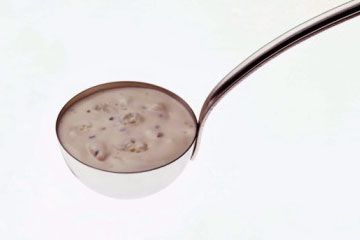Sea salt has been pouring off store shelves in a tidal wave-like surge recently. This ocean borne option has been steadily gaining in popularity in recent years, partly due to the increased consumer perception that the crystals are lower in sodium than regular table salt. Technically, this is true, but don't toss out your salt shaker for a pile of sea rocks just yet.
Despite the claims of some inventive but misleading marketing campaigns, lower sodium in this case means nothing, as the total difference in sodium content between sea salt and table salt is less than 2 percent (yes, 0.02). That's not to say, however, that sea salt isn't a healthier option than table salt or that it can't help reduce a person's sodium intake.
Advertisement
Really, salt (sea or otherwise) should be a poisonous metal. It's a combination of the easily combustible metal sodium (Na) and the poisonous gas chlorine (Cl) -- of swimming pool fame. When the two elements are combined, we get salt (NaCl), which is 40 percent sodium and 60 percent chlorine.
Sodium is used as both an electrolyte and a mineral. It's necessary for transporting oxygen, nutrients and nerve impulses throughout the body. It also plays a large role in muscle movement, so your heart wouldn't beat without it. Chlorine, on the other hand, is necessary for both respiration and digestion.
We couldn't survive without either element, but those who consume high levels of sodium are more likely to develop cardiovascular, liver and kidney diseases and often have high blood pressure. Therefore, it's not surprising that table salt has earned a bad rap, as it is most people's primary sodium source (though the mineral also frequently appears in processed foods).
Table salt comes primarily from underground salt mines and is finely ground. It usually consists of 99 to 99.9 percent NaCl, meaning it's nearly 40 percent pure sodium. Table salt's 0.01 to 0.1 percent of additives include:
- Potassium iodide - helps prevent iodine deficiency diseases, such as thyroid disease. When this element is added to table salt, it becomes iodized salt.
- Dextrose - acts as a stabilizer for potassium iodide
- Sugar - provides sweetness
- Sodium ferrocyanide - acts as an anti-caking agent
- Ferric ferrocyanide - also acts as an anti-caking agent. Interestingly, ferric ferrocyanide is an FDA-registered toxic pollutant.
By comparison, sea salt isn't too much better for us, at least in terms of sodium content. As the name implies, sea salt is derived from ocean water, and its grains are large, coarse and unrefined. It's usually made up of between 98 and 99 percent sodium chloride, meaning it contains approximately 39 percent sodium. It also has a few more additives than the tabletop version, but as long as the sea salt is all-natural, these extras will be ocean-absorbed minerals such as magnesium, sulfur or iodine, not chemicals or processed additives.
Many people believe sea salt's natural minerals enhance flavor and provide an added health boost, which is one reason for the condiment's continued popularity. As we mentioned earlier, however, sea salt's biggest selling point is the claim that it contains less sodium than regular table salt. That assertion is pure hyperbole, but replacing table salt with sea water rocks can still lower your blood pressure. Sea salt's unrefined crystals are larger and more flavorful than table salt's, so you can use less and it will taste like more.
Advertisement


